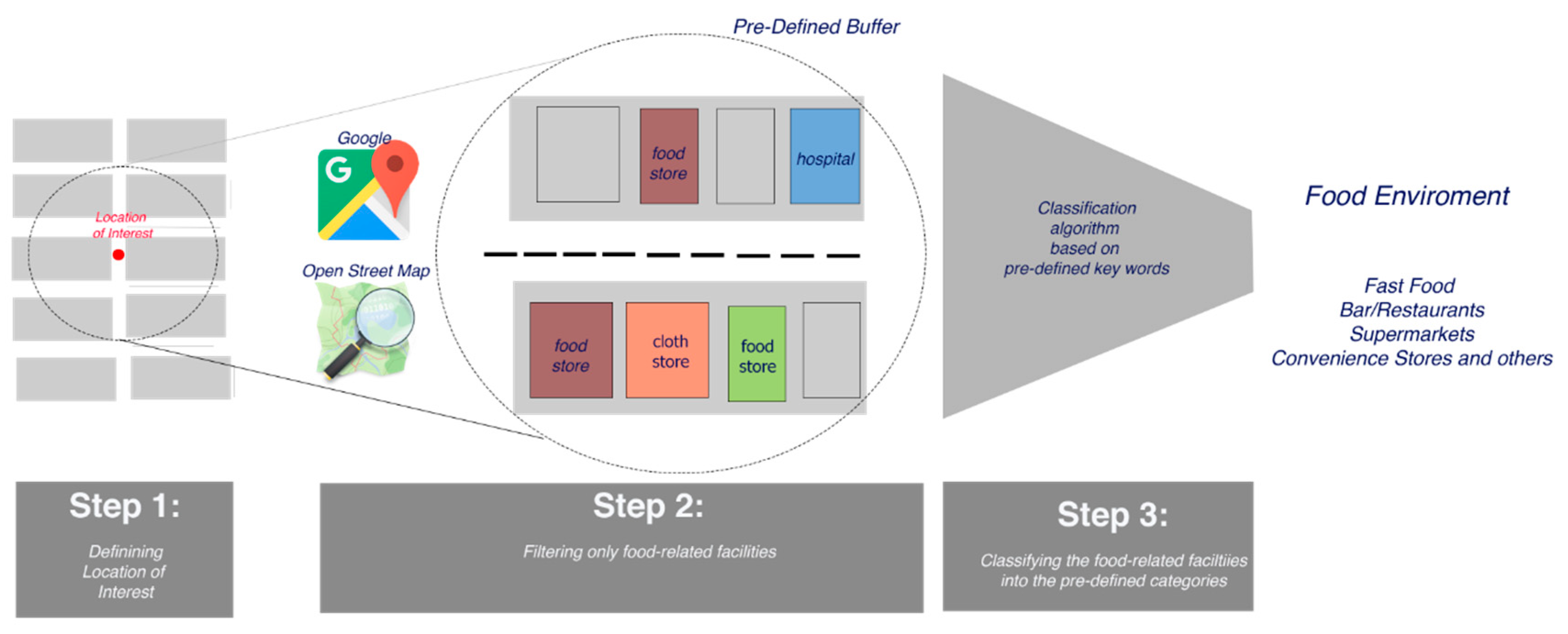Introducing the Facility List Coder: A New Dataset/Method to Evaluate Community Food Environments
Abstract
1. Summary
2. Data Description
2.1. Format
2.2. Data Structure
3. Methods
Instructions to Use the FLC in Any Specific Context
4. Final Remarks
Supplementary Materials
Author Contributions
Funding
Conflicts of Interest
References
- Glanz, K.; Sallis, J.F.; Saelens, B.E.; Frank, L.D. Healthy Nutrition Environments: Concepts and Measures. Am. J. Health Promot. 2005, 19, 330–333. [Google Scholar] [CrossRef] [PubMed]
- Williams, J.; Scarborough, P.; Matthews, A.; Cowburn, G.; Foster, C.; Roberts, N.; Rayner, M. A systematic review of the influence of the retail food environment around schools on obesity-related outcomes. Obes. Rev. 2014, 15, 359–374. [Google Scholar] [CrossRef] [PubMed]
- Pitt, E.; Gallegos, D.; Comans, T.; Cameron, C.; Thornton, L. Exploring the influence of local food environments on food behaviours: A systematic review of qualitative literature. Public Health Nutr. 2017, 20, 2393–2405. [Google Scholar] [CrossRef] [PubMed]
- Cobb, L.K.; Appel, L.J.; Franco, M.; Jones-Smith, J.C.; Nur, A.; Anderson, C.A.M. The relationship of the local food environment with obesity: A systematic review of methods, study quality, and results. Obesity 2015, 23, 1331–1344. [Google Scholar] [CrossRef] [PubMed]
- McKinnon, R.A.; Reedy, J.; Morrissette, M.A.; Lytle, L.A.; Yaroch, A.L. Measures of the Food Environment. A Compilation of the Literature, 1990–2007. Am. J. Prev. Med. 2009, 36, S124–S133. [Google Scholar] [CrossRef] [PubMed]
- Lytle, L.A.; Sokol, R.L. Measures of the food environment: A systematic review of the field, 2007–2015. Health Place 2017, 44, 18–34. [Google Scholar] [CrossRef] [PubMed]
- Caspi, C.E.; Sorensen, G.; Subramanian, S.V.; Kawachi, I. The local food environment and diet: A systematic review. Health Place 2012, 18, 1172–1187. [Google Scholar] [CrossRef] [PubMed]
- Arcila-Agudelo, A.M.; Muñoz-Mora, J.C.; Farran-Codina, A. Validity and Reliability of the Facility List Coder, a New Tool to Evaluate Community Food Environments. Int. J. Environ. Res. Public Health 2019, 16, 3578. [Google Scholar] [CrossRef] [PubMed]
- Wilkins, E.L.; Morris, M.A.; Radley, D.; Griffiths, C. Using Geographic Information Systems to measure retail food environments: Discussion of methodological considerations and a proposed reporting checklist (Geo-FERN). Health Place 2017, 44, 110–117. [Google Scholar] [CrossRef] [PubMed]
- Lake, A.A.; Burgoine, T.; Greenhalgh, F.; Stamp, E.; Tyrrell, R. The foodscape: Classification and field validation of secondary data sources. Health Place 2010, 16, 666–673. [Google Scholar] [CrossRef] [PubMed]
- Consell d’Administració de l’Agència de Salut Pública de Catalunya. Criteris Registrals per a establiments Minoristes D’alimentació de Catalunya [Registration Criteria for Food Retail Establishments in Catalonia] v.2. 2012. Available online: https://www.diba.cat/c/document_library/get_file?uuid=2b7c167f-cf4b-452d-a8a4-acb2f8d90b17&groupId=713456 (accessed on 10 March 2020).
- Wilkins, E.L.; Radley, D.; Morris, M.A.; Griffiths, C. Examining the validity and utility of two secondary sources of food environment data against street audits in England. Nutr. J. 2017, 16, 82. [Google Scholar] [CrossRef] [PubMed]

| Variable Name | Type | Description |
|---|---|---|
| category | Factor | Facility classification using the predefined classification |
| dist_cycling | Numeric/Float | Cycling distance from the facility to the interest point |
| dist_km | Numeric/Float | Road distance from the facility to the interest point |
| dist_walking | Numeric/Float | Walking time from the facility to the point |
| geo_id | String | ID from the spatial search engine (google/osm) |
| geo_web | String | Webpage available from the geo-engine |
| place_address | String | Facility address |
| place_lat | Numeric/Float | Facility location—latitude |
| place_lng | Numeric/Float | Facility location—longitude |
| place_name | String | Facility name |
| place_phone_number | String | Facility phone number |
| place_web | String | Facility webpage (if available) |
| li_id | Numeric/Float | Location of interest—ID |
| li_lat | Numeric/Float | Location of interest—latitude |
| li_lng | Numeric/Float | Location of interest—longitude |
| li_name | String | Location of interest—name |
| International Category | Subcategory | Other Information |
|---|---|---|
| Bars/Restaurants/Bakery | Bakery | Pastry shop |
| Bar, Restaurant | Kiosk | |
| Fast-Food Restaurants | Fast-Food Restaurant | Churreria, frankfurt |
| Ice Cream Store | Orcheteria | |
| Supermarkets | Supermarket | Local market, grocery store, frozen store, mini markets |
| Specialty Stores and Others | Fish Shop | |
| Fruit, Vegetable Store | ||
| Eggs Store | ||
| Dairy Products | Cheese shop | |
| Oil Shop | ||
| Butchery | Butcher shop |
© 2020 by the authors. Licensee MDPI, Basel, Switzerland. This article is an open access article distributed under the terms and conditions of the Creative Commons Attribution (CC BY) license (http://creativecommons.org/licenses/by/4.0/).
Share and Cite
Arcila-Agudelo, A.M.; Muñoz-Mora, J.C.; Farran-Codina, A. Introducing the Facility List Coder: A New Dataset/Method to Evaluate Community Food Environments. Data 2020, 5, 23. https://doi.org/10.3390/data5010023
Arcila-Agudelo AM, Muñoz-Mora JC, Farran-Codina A. Introducing the Facility List Coder: A New Dataset/Method to Evaluate Community Food Environments. Data. 2020; 5(1):23. https://doi.org/10.3390/data5010023
Chicago/Turabian StyleArcila-Agudelo, Ana María, Juan Carlos Muñoz-Mora, and Andreu Farran-Codina. 2020. "Introducing the Facility List Coder: A New Dataset/Method to Evaluate Community Food Environments" Data 5, no. 1: 23. https://doi.org/10.3390/data5010023
APA StyleArcila-Agudelo, A. M., Muñoz-Mora, J. C., & Farran-Codina, A. (2020). Introducing the Facility List Coder: A New Dataset/Method to Evaluate Community Food Environments. Data, 5(1), 23. https://doi.org/10.3390/data5010023





